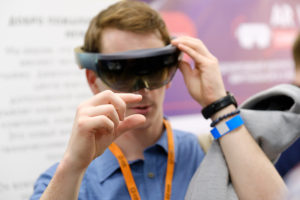There is no doubt the manufacturing industry is advancing: Humans are working alongside cobots, big data is allowing decision-makers to make more educated and predictive decisions, and machine learning is making its mark on plant productivity. While some manufacturers are wary of incorporating an ever-growing amount of technology into their plants, many are catching on and realizing that not taking the leap could mean falling behind. Another way in which technology is playing a role in manufacturing — and will likely play a greater role in the future — is through augmented reality (AR) and virtual reality (VR). So, what’s the difference between the two and what are some practical ways manufactures are using this technology?
 In VR, everything is a “computer-generated simulation or recreation of a real life environment or situation.” There are no real-time components to VR. It only feels like real-time to users because they’re viewing these simulations clearly and up close. The key differentiator is that, in AR, users see real-time scenarios accompanied with “computer-generated enhancements” that allow for user interaction. And many are incorporating mixed reality (MR), a combination of real and virtual environments with computer-generated simulations and enhancements.
In VR, everything is a “computer-generated simulation or recreation of a real life environment or situation.” There are no real-time components to VR. It only feels like real-time to users because they’re viewing these simulations clearly and up close. The key differentiator is that, in AR, users see real-time scenarios accompanied with “computer-generated enhancements” that allow for user interaction. And many are incorporating mixed reality (MR), a combination of real and virtual environments with computer-generated simulations and enhancements.
In manufacturing, these realities — whether simulated or real — are helping companies enhance operations beyond projected assembly instructions for complex work.
- Training — When plant floor employees can interact with AR, VR, or MR modules, they can learn from the information their devices project. Plus, training information can be built around personnel members’ existing knowledge, so unnecessary training doesn’t take valuable time, which means training is also personalized for individual growth. Considering the skills gap, allowing manufacturers to learn more autonomously and as they perform tasks also takes a trainer out of the equation, which not only reduces the number of manufacturers necessary for training purposes but can also ensure knowledge consistency for trainees, helping to ensure consistent quality of work as well.
- Maintenance — Like assembly, AR and MR maintenance instructions can take manufacturers through maintenance processes step by step, eliminating the need for clunky maintenance manuals and showing employees exactly how machine elements should look and function. In addition, specialists can use AR to “visit” manufacturing plants from nearly anywhere to perform regularly scheduled maintenance and plant walk-through inspections via plant floor employee devices and video feeds. This application can save plant leaders time and money as opposed to waiting until these experts are available and flying them to their plants as well as providing accommodations. With experts available in near-real time, another maintenance benefit is safety as these specialists can catch issues that could cause accidents resulting in injuries or damage.
- Inventory — With well-mapped inventories, AR- and MR-equipped manufacturers can use their devices to take them to the exact items they need. Especially useful for those with large, complex warehouses, the use of AR and MR allows quicker picking, enhancing efficiency and productivity by allowing manufacturers to use the time they’d otherwise spend searching to move onto the next item. In addition, manufacturers can have more control over their inventories when each box is labeled with its appropriate tag for identification as they can more easily manage what they’ve got — and be prepared to order in advance of running out of their most important stock.

With so many possibilities, is it time you introduced a new reality to your plant? Whether you choose AR, VR, MR, or any combination of advanced manufacturing technologies, ensure your investment will be valuable to your employees and worth the upgrade cost in the long run.
